Plant a Japanese maple (
Acer spp and cvs, USDA zones 5 to 8; find your zone) in your garden, then stand back and see all it brings to your space. Colorful foliage, texture, year-round interest, sculptural presence and juxtaposition are things that immediately come to mind. Indeed, few other plants can bring this much to the garden plate.
I recently visited Mr. Maple, a Japanese maple nursery near Asheville, North Carolina, that is run by brothers Tim and Matt Nichols. The nursery began as a hobby for their father, Norman, and now sells over 1,000 cultivars, making it the largest source for Japanese maple cultivars in the U.S.
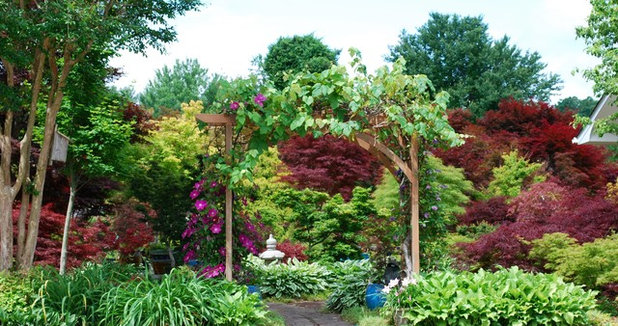
Jay Sifford Garden Design
Their display garden, shown here, is an almost surreal kaleidoscope of color, form, size and texture. I spoke to Matt and Tim about their top choices for Japanese maples that thrive in full sun. These are their favorites.
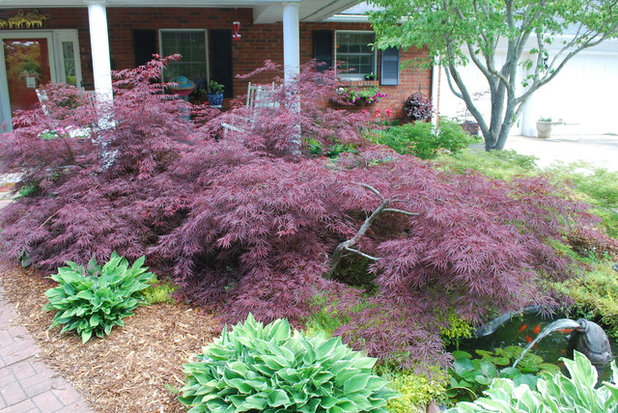
Jay Sifford Garden Design
‘Tamukeyama’. This tree, whose name translates to “hands folded in prayer on the mountain,” is an easily sourced cultivar that embodies all that people love about Japanese maples. Tim says that Tamukeyama is better adapted to full sun than the older standard cultivar ‘Crimson Queen’. This tree will fade to a muddy reddish green if it is planted in a shadier part of the garden.
The foliage emerges later in the spring than that of other maple cultivars, which makes it more suitable for colder climates where frost damage is prevalent. Tamukeyama grows to a height and width of 8 feet. The fall color is a brilliant red.
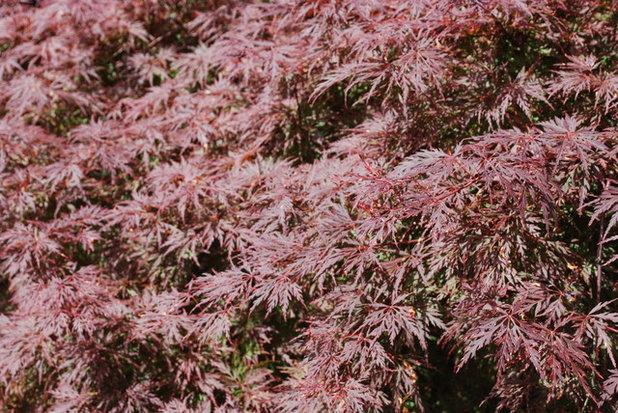
Jay Sifford Garden Design
‘Orangeola’. Matt recommends this cultivar based on the fact that it sports three foliage colors: green, red and orange-pink. The fall color is a brilliant orange. Orangeola has very dissected leaves that are unique in shape and very lacy.
Orangeola has received an Award of Merit from the Royal Horticultural Society. It grows to an average size of 4 feet tall and wide and is a strong performer in full sun.
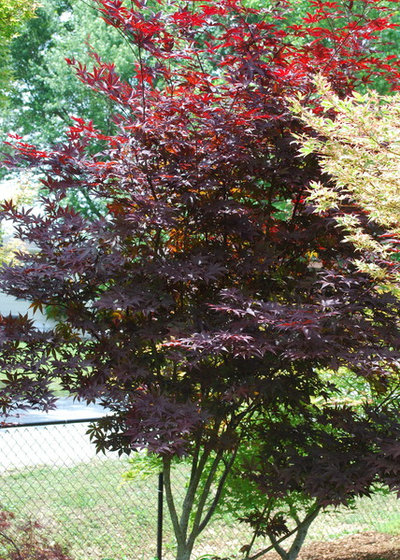
Jay Sifford Garden Design
‘Red Emperor’. This cultivar, also known as ‘Emperor 1’, is an improved form of the popular ‘Bloodgood’. It has a shinier, darker red leaf than Bloodgood, with a green underside. It leafs out two weeks later than Bloodgood, which, like Tamukeyama, is advantageous in colder climates.
This cultivar, introduced by Richard P. Wolff of Red Maple Nursery in Pennsylvania, is hardy to zone 9, making it a superior choice for hot, humid climates.
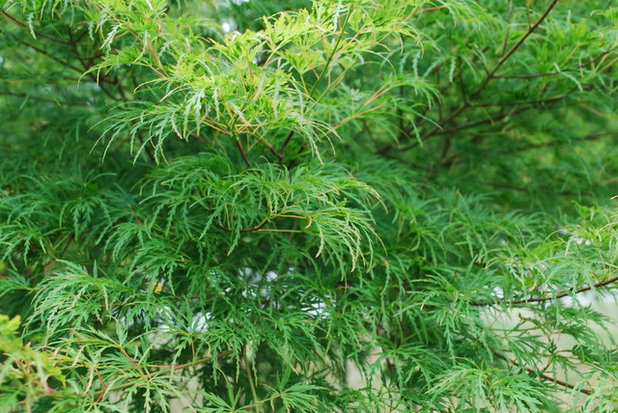
Jay Sifford Garden Design
‘Seiryu’. This cultivar sports chartreuse foliage and is one of the few upright lace-leaf Japanese maples. While many maples with green foliage burn in full sun, Seiryu shines. Tim says that this cultivar, whose name translates as “blue-green dragons,” is one of the fastest growing of all Japanese maples, reaching a height of 20 to 22 feet.
This cultivar was introduced by Wada Nursery in 1972 and first found a home in the U.S. at the National Arboretum. Its fall coloration is a brilliant scarlet.
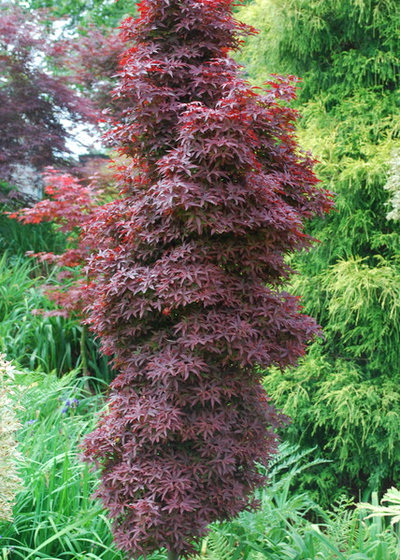
Jay Sifford Garden Design
‘Twombly’s Red Sentinel’. Ken Twombly, of Twombly Nursery in Connecticut, found this cultivar in a Connecticut church yard. It is presumed to be a witch’s broom (a naturally occurring anomaly, generally globose in shape, of Bloodgood).
Its columnar shape is unique, and it reaches 10 feet tall and 3 feet wide in 15 years. Matt recommends Twombly’s Red Sentinel for smaller spaces. Its fall coloration is a brilliant scarlet.
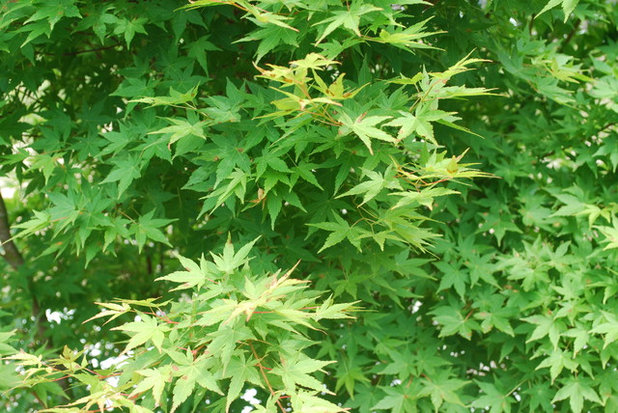
Jay Sifford Garden Design
‘Tsukasa Silhouette’. Like Twombly’s Red Sentinel, Tsukasa Silhouette has a very columnar form, making it ideal for small urban spaces. This cultivar sports chartreuse foliage in spring and darker green leaves in summer, changing to a brilliant scarlet in autumn.
Tim says that this fast-growing cultivar exceeds 1 foot of growth per year, topping out at 20 feet tall and 6 feet wide. Matt adds that he has a customer growing this tree in full sun in Dallas, proving its tolerance for heat and humidity.
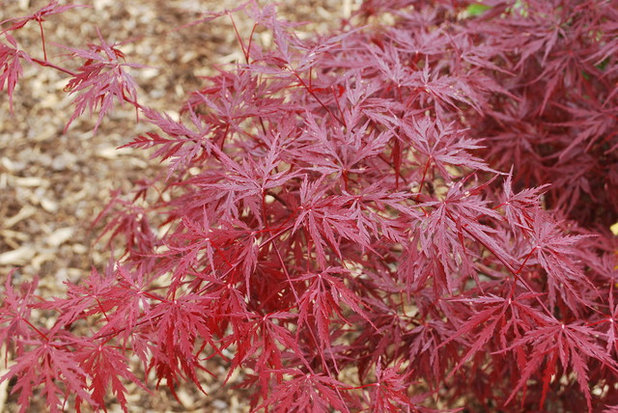
Jay Sifford Garden Design
‘Monticello Gardens’. Matt and Tim call this cultivar the premium red for high-heat zones. It holds its red coloration better than most cultivars throughout the season and does not scorch in full sun. It is, Matt and Tim say, the star of a new generation of red Japanese maples.
Monticello Gardens is a small cultivar, growing to 5 feet tall and wide in 20 years.
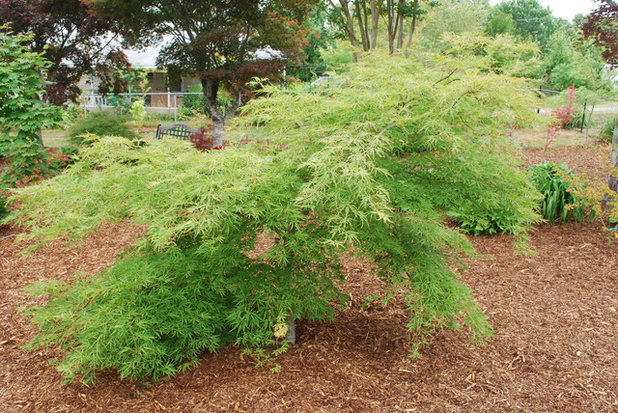
Jay Sifford Garden Design
‘Germaine’s Gyration’. This cultivar, also known as ‘Contorta’, is the largest-growing pendulous lace-leaf Japanese maple in existence. It can easily reach 12 feet tall and wide in 15 years. Matt calls it the Mack truck of Japanese maples for its large size, strength and dependability.
Germaine’s Gyration has an unusual spiraling growth habit and tiered foliage. Its fall coloration is a bold orange. It performs reliably as far south as zone 9.
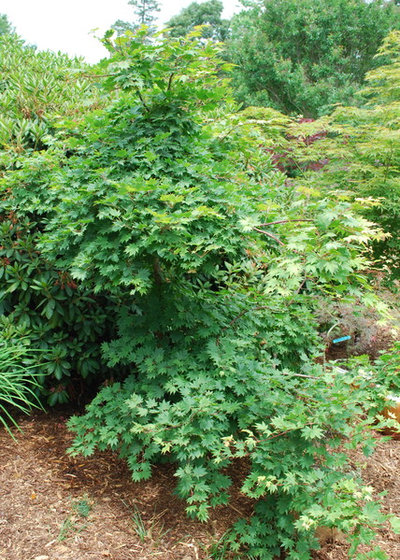
Jay Sifford Garden Design
‘Seki no kegon’. This
A. sieboldianum cultivar is one of the most cold-tolerant Japanese maples in existence. If grafted onto
sieboldianum root stock, Matt and Tim say, it performs reliably as far north as Wisconsin.
Tim describes this cultivar as a weeping maple similar to full moon maple. This very recently introduced cultivar grows to a height of 6 to 8 feet in 15 years. This green-leaved tree has a brilliant red fall color.
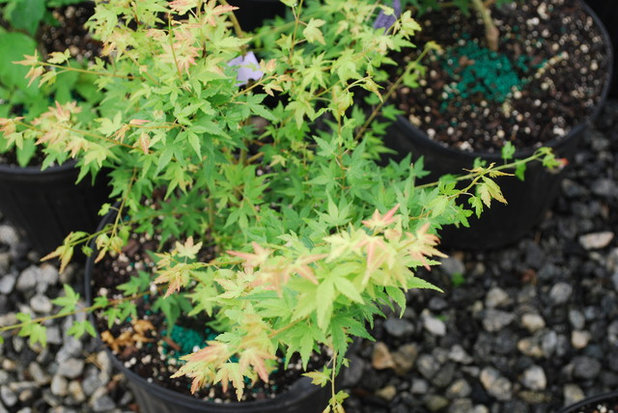
Jay Sifford Garden Design
‘Saiho’. “Saiho” is a Japanese word translated as “paradise.” It is a dwarf, globe-shaped cultivar that reaches a 15-year size of 5 feet tall and 4 feet wide. Because of this, and the fact that it sports tiny leaves, Saiho makes a good choice for bonsai.
Saiho is very heat tolerant and performs well without scorching in full sun.
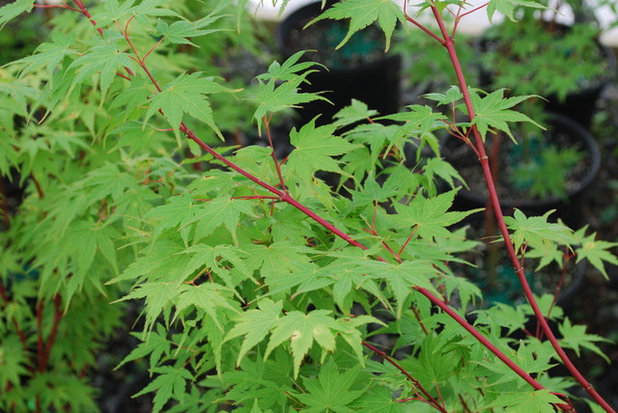
Jay Sifford Garden Design
‘Sango-kaku’. This widely planted cultivar has a name that translates as “coral tower” and is commonly known as coral bark maple. It is grown primarily for winter interest, as its bark turns a bright red in winter after sporting hues of orange and yellow during the warmer months. Sango-kaku sports light green leaves that turn yellow in autumn. It grows to a height of 18 to 20 feet.
Be advised that if planted in shade, this tree may not reach its potential for winter bark coloration.
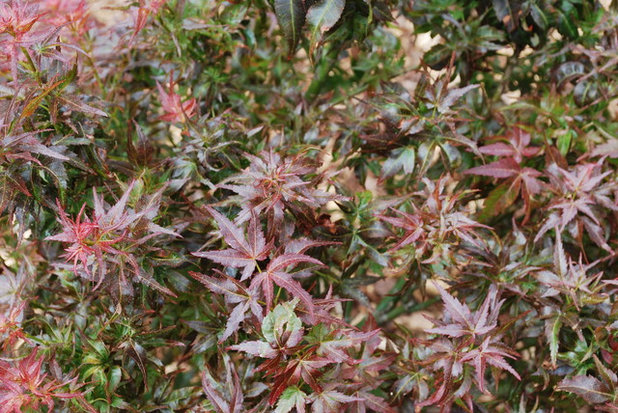
Jay Sifford Garden Design
‘Kurenai jishi’. The name of this maple translates to “black lion,” and it is sometimes referred to as “the red ‘Shishigashira’.” Its spring coloration is a deep red, bordering on black, with brighter growth on the branch tips. It is full and compact, with heavy texture. Kurenai jishi will reach a 10-year size of 4½ feet tall and 3 feet wide.
More:13 Japanese Maples for Shade
See more guides to growing trees on Houzz





